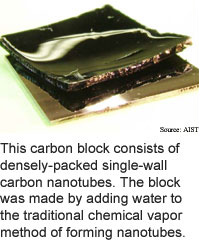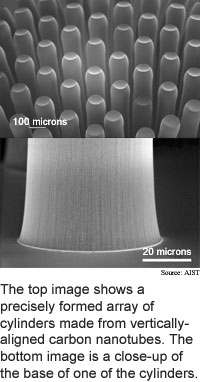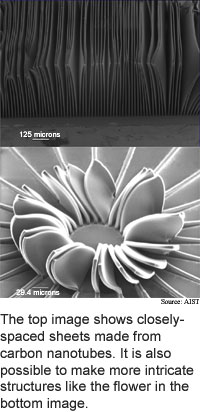
For pure nanotubes add water
By
Eric Smalley,
Technology Research NewsWashing away impurities with water turns out to be as good for growing carbon nanotubes as it is for keeping a clean house.
Carbon nanotubes show great promise as building blocks for molecular machines, high-speed electronics and super-strong materials, but it has proven difficult to reliably grow large amounts of pure carbon nanotubes and to keep the growth process orderly.
The long, rolled-up sheets of carbon atoms can be narrower than a single nanometer, have useful electrical, optical, and magnetic properties, and are stronger by weight than steel. A nanometer is one millionth of a millimeter, or the span of 10 hydrogen atoms.
Researchers from the Japanese National Institute of Advanced Industrial Science and Technology (AIST) have added water to the standard method of manufacturing carbon nanotubes to produce tall, dense, vertically-aligned stands of pure nanotubes. The researchers' demonstrations have yielded stands of single-wall carbon nanotubes as tall as 2.5 millimeters and 99.98 percent pure. Individual nanotubes range from one to three nanometers in diameter.
The purity of the nanotubes makes the usual post-growth purification process unnecessary. This makes the method quicker, less expensive and less likely to damage the nanotubes than existing processes, said Kenji Hata, a senior researcher at the Japan National Institute of Advanced Industrial Science and Technology. Nanotubes produced using the method are orderly and pure enough for use in many fields, including biology, medical implants, chemistry, electronics and magnetics research, he said.
Carbon nanotubes are typically grown using chemical vapor deposition techniques. These involve heating surfaces like silicon wafers or metal foil that contain microscopic metal particles in the presence of gases like methane or ethylene. The metal particles act as catalysts that extract carbon atoms from the gases; the carbon atoms then naturally form nanotubes.
Ordinarily growth stops after about one minute as disorganized carbon soot accumulates. Water removes this amorphous carbon layer, making more catalysts particles active so that more nanotubes grow, and keeping the catalysts active longer to produce taller nanotubes. "This synthesis is highly efficient, meaning that almost all the catalysts on the surface are active in growing tubes," said Hata.
The high density of the nanotubes causes them to grow vertically rather than in many directions. "This is all due to the use of water," said Hata. If the number of nanotubes in a given space is too low "the tubes would not be able to stand and form these structures [and] you would end up with a pile of spaghetti," he said.
The nanotube structures can be easily removed from the surfaces and the catalysts used again to produce new structures, said Hata.
Because the water keeps amorphous carbon from the samples, the process does not require a step to remove the amorphous carbon.
The researchers' demonstrations have shown that growth can continue for as long as 30 minutes. Their fastest growth to date is a 10-minute 2.5-millimeter sample.
The researchers used lithography techniques to pattern the catalysts on surfaces in order to grow various three-dimensional structures, including arrays of cylinders and sheets. The researchers produced cylinders 1 millimeter tall and about one third of a millimeter in diameter. They also produced 10-micron thick sheets that can be laid flat to form thin films of pure carbon.
The method could be used to mass produce carbon nanotubes within five years, and for practical applications within ten years, said Hata.
Hata's research colleagues were Don N. Futaba, Kohei Mizuno, Tatsunori Namai, Motoo Yumura and Sumio Iijima. The work appeared in the November 19, 2004 issue of Science. The research was funded by the Japan National Institute for Advanced Industrial Science and Technology (AIST) and the New Energy and Industrial Technology Development Organization (NEDO).
Timeline: 5 years, 10 years
Funding: Government
TRN Categories: Nanotechnology; Materials Science and Engineering
Story Type: News
Related Elements: Technical paper, "Water-Assisted Highly Efficient Synthesis of Impurity-Free Single-Walled Carbon Nanotubes," Science, November 19, 2004
Advertisements:
December 1/8, 2004
Page One
For pure nanotubes add water
Solar cell doubles as battery
Conversational engagement tracked
Pure silicon laser debuts
Briefs:
Tight twist toughens nanotube fiber
Multicamera surveillance automated
Chemical keeps hydrogen on ice
Smart dust gets magnetic
Short nanotubes carry big currents
Demo advances quantum networking



News:
Research News Roundup
Research Watch blog
Features:
View from the High Ground Q&A
How It Works
RSS Feeds:
News
Ad links:
Buy an ad link
| Advertisements:
|
 |
Ad links: Clear History
Buy an ad link
|
TRN
Newswire and Headline Feeds for Web sites
|
© Copyright Technology Research News, LLC 2000-2006. All rights reserved.